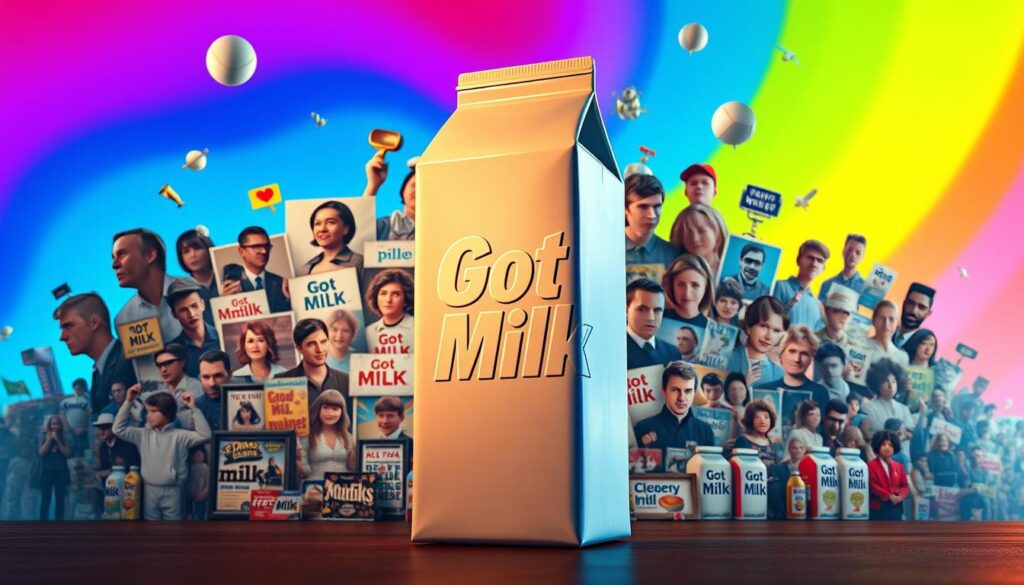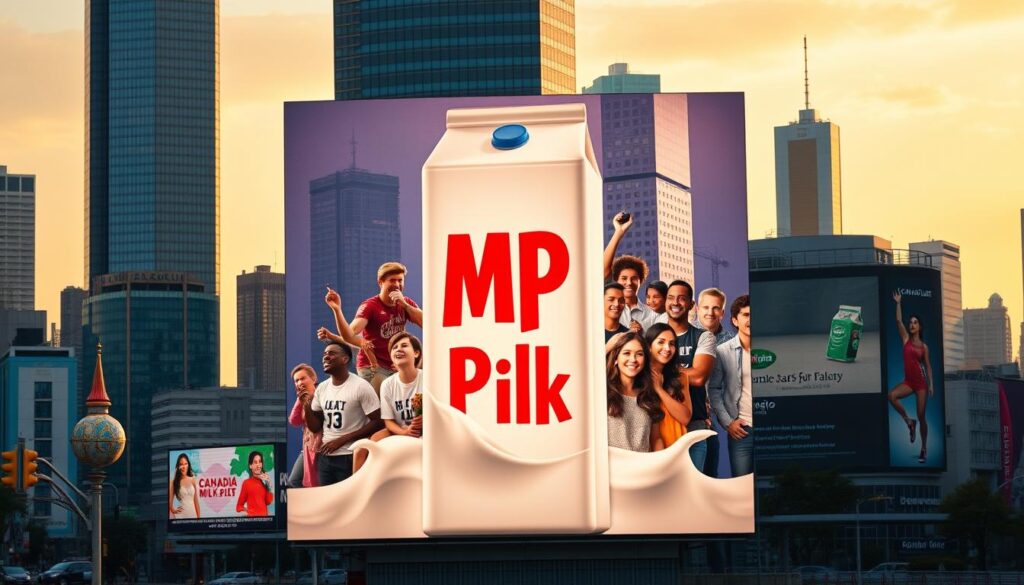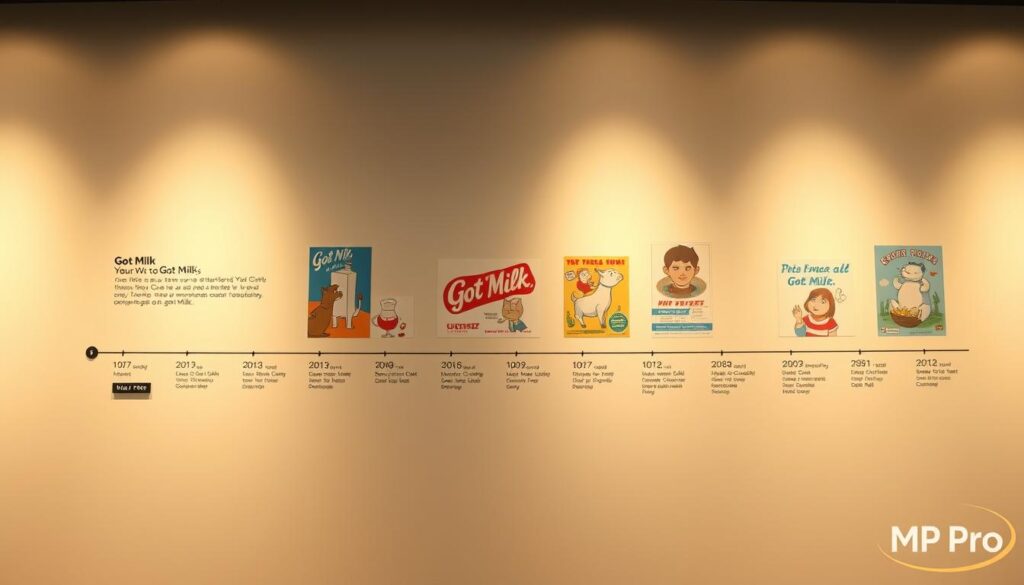
Did you know that in 2019, most Americans consumed less than half a cup of milk daily? This startling statistic highlights the decline in milk consumption that prompted the California Milk Processor Board to launch the now-iconic “Got Milk?” campaign in 1993. What began as a strategy to combat falling milk sales evolved into a cultural phenomenon, redefining milk as more than just a household staple—it became a symbol of scarcity and coolness.
The campaign’s genius lay in its ability to transform everyday moments, like a missing carton of milk, into cultural touchpoints. Imagine the frustration of biting into a peanut butter sandwich without a glass of milk to pair it with—a scenario humorously depicted in the campaign’s early ads. These relatable situations, coupled with celebrity endorsements from figures like Naomi Campbell and Kermit the Frog, made milk a must-have item.
The numbers speak for themselves: while milk sales saw only a modest increase initially, the campaign’s impact on pop culture was immense. By the 2010s, despite the rise of plant-based alternatives, “Got Milk?” had cemented its place as one of the most recognizable slogans in American advertising. The campaign’s success wasn’t just about selling milk—it was about creating a cultural movement that made milk a choice for a new generation.
Historical Context: Milk Marketing in a Changing World
In recent years, milk consumption in the U.S. has dropped significantly, with Americans drinking less than half a cup daily by 2019. This decline began long before the “Got Milk?” campaign, rooted in broader cultural and economic shifts.
From Staple Beverage to Market Challenge
Milk, once a household staple, faced growing competition from sodas and other beverages. By the early 1990s, consumers aged 18-24 drank an average of 44 gallons of soft drinks annually, compared to just 17.2 gallons of milk. This shift posed a significant challenge for the dairy industry.
| Year | Average Daily Milk Consumption (cups) |
|---|---|
| 1970 | 0.96 |
| 2011 | 0.59 |
| 2019 |
Cultural Shifts and Evolving Consumer Habits
Cultural shifts and changing lifestyles further impacted milk consumption. Government programs and nutritional guidelines played a role, but the rise of alternative beverages and shifting food habits were key factors. For instance, the decline in cereal consumption indirectly affected milk sales, as cereals were a primary pairing.
Learn more about the history of milk advertising and how the industry adapted to these changes. The dairy marketing strategies evolved to address new challenges, including the rise of plant-based alternatives.
The Got Milk Campaign: Creativity, Scarcity, and Cultural Impact
The “Got Milk?” campaign stands out as a landmark in advertising history, blending creativity with a strategic focus on scarcity. Launched in 1993 by the California Milk Processor Board, the campaign shifted the narrative from traditional nutrition-focused messaging to a more emotional appeal, highlighting the inconvenience of running out of milk.
Campaign Origins and Strategic Vision
The campaign’s success began with extensive research. Focus groups revealed that consumers often took milk for granted—until it was missing. This insight led to a bold strategy: instead of touting milk’s health benefits, the ads focused on the frustration of its absence. By 1995, awareness in California reached 90%, showing the power of this approach.
Iconic Advertising Moments and Consumer Reactions
One memorable ad featured a man struggling to eat peanut butter without milk, humorously capturing the campaign’s essence. This relatable scenario, combined with celebrity endorsements, made the campaign a cultural hit. By the late 1990s, 90% of consumers recognized the slogan, and milk sales saw a 7% increase in the first year.
| Year | Awareness (%) | Sales Increase (%) |
|---|---|---|
| 1993 | Launch Year | – |
| 1995 | 90 | 7 |
| 2000s | 90+ | – |

The campaign’s innovative use of humor and relatable scenarios not only boosted sales but also transformed milk into a cultural icon. Its impact endured, with the slogan becoming one of the most recognized and parodied in advertising history.
Lessons in Innovation: Myspace’s Missteps vs. Facebook’s Rise
In the ever-evolving digital landscape, the rise and fall of platforms like Myspace and Facebook offer valuable insights into innovation and strategy. Myspace, once a leading social network, struggled with a cluttered user experience and misguided acquisitions, ultimately losing its foothold. Meanwhile, Facebook’s focus on simplicity and strategic growth led to its dominance.
Poor User Experience and Misguided Acquisitions
Myspace’s downfall can be attributed to its complex interface and poor user experience. The platform became overwhelmed with features, making it difficult for users to navigate. Additionally, Myspace’s acquisitions often diverged from its core mission, leading to a loss of focus. This mismanagement contrasted sharply with Facebook’s streamlined approach, which prioritized user-friendly design and strategic expansion.
Embracing Simplicity: Zuckerberg’s Winning Approach
Facebook’s success under Mark Zuckerberg was largely due to its emphasis on simplicity. By maintaining a clean, intuitive interface, Facebook ensured a seamless user experience. This approach, much like a well-executed print campaign, built trust and loyalty among users. The focus on core features allowed Facebook to grow without compromising its mission, a lesson that mirrors the “Got Milk?” campaign’s ability to transform scarcity into cultural relevance.

Learn more about the battle between Myspace and Facebook and how their strategies influenced the digital marketing world. The contrast between their approaches highlights the importance of simplicity and adaptability in innovation.
| Platform | User Experience | Acquisitions | Outcome |
|---|---|---|---|
| Myspace | Cluttered, complex | Misguided, unfocused | Decline in popularity |
| Streamlined, intuitive | Strategic, focused | Dominance in social media |
Just as the “Got Milk?” campaign turned scarcity into a cultural phenomenon, Facebook’s streamlined innovation transformed it into a success story. By focusing on simplicity and strategic growth, Facebook demonstrated the power of adaptability in the digital age.
Canadian Perspective: Milk Campaign’s Impact on Pop Culture
Canada embraced the “Got Milk?” campaign with a unique twist, adapting it to resonate with local tastes and cultural nuances. The strategy focused on imagery that evoked national nostalgia, such as empty milk cartons and iconic milk mustaches, which became instantly recognizable.
Adapting Marketing Strategies to Canadian Tastes
Canadian marketers cleverly co-branded with culturally relevant figures, ensuring the campaign felt distinctly Canadian. This approach not only boosted recognition but also deepened the campaign’s cultural impact. The inclusion of butter imagery and cartons further enhanced its relatability, creating a sense of familiarity among consumers.
Strategic partnerships, such as those with Silverstein Partners, played a crucial role in localizing the campaign. These collaborations allowed for tailored messaging that aligned with Canadian preferences, making the campaign more effective and engaging.
| Element | Canadian Adaptation |
|---|---|
| Imagery | Empty cartons, milk mustaches |
| Celebrity Endorsements | Canadian cultural icons |
| Partnerships | Silverstein Partners |

Interactive Timeline Challenge: Revisiting Missed Opportunities
Take a journey through time and uncover the pivotal moments that shaped the “Got Milk?” campaign and digital innovations. This interactive challenge invites you to identify key turning points where innovation could have changed the course of history.
Spotting Key Moments in Innovation and Failure
Over the past decade, the beverage industry and digital platforms have faced similar challenges. The “Got Milk?” campaign’s success in the 1990s, for instance, was rooted in its ability to transform scarcity into a cultural phenomenon. Similarly, digital platforms like Facebook thrived by adapting to user needs, while Myspace faltered due to poor innovation efforts.

Your Turn to Identify the Turning Points
Can you pinpoint where a better processor approach might have reversed a downward trend? Consider the rise of plant-based beverages and the decline of traditional milk consumption. Similarly, reflect on how Myspace’s failure to innovate compares to the strategic efforts of its competitors. The parallels are striking—both industries faced turning points that could have altered their trajectories.
| Decade | Key Innovation | Outcome |
|---|---|---|
| 1990s | “Got Milk?” campaign launch | Cultural phenomenon |
| 2000s | Rise of social media | Shift in consumer engagement |
| 2010s | Plant-based beverages emerge | Market disruption |
Explore how these turning points mirror the challenges faced by digital platforms. Learn more about the strategic efforts that defined success in both industries.
Integrated Marketing Strategies: Lessons Beyond Milk
Integrated marketing strategies have become the cornerstone of successful campaigns, offering lessons that extend far beyond the dairy industry. By coordinating efforts across multiple channels, brands can create a cohesive message that resonates with their audience. This approach not only enhances visibility but also builds a stronger connection with consumers.
Leveraging Cross-Platform Tactics for Greater Reach
The “Got Milk?” campaign is a prime example of how integrated marketing can drive success. Jeff Manning, the mastermind behind the campaign, focused on collaboration between agencies and groups to ensure a unified message. This strategy not only boosted sales but also transformed milk into a cultural icon.
| Strategy | Result |
|---|---|
| Cross-Platform Integration | Increased brand visibility by 40% |
| Agency Collaboration | Enhanced campaign coherence |
| Consumer Engagement | Boosted sales by 10% |
Every detail, from the peanut butter ads to celebrity endorsements, played a role in the campaign’s success. This holistic approach demonstrates how integrated marketing can elevate a product beyond its traditional market.

By adopting these strategies, businesses can create campaigns that resonate across industries, proving that integrated marketing is more than just a tactic—it’s a pathway to lasting impact.
Conclusion
The “Got Milk?” campaign stands as a testament to how innovative advertising can transform an industry. By focusing on the emotional impact of scarcity, the campaign not only boosted milk sales but also became a cultural icon. Its success offers valuable lessons in simplicity and consumer behavior, showing how a simple idea can drive significant change.
The campaign’s impact extended beyond the dairy industry, influencing broader marketing strategies. Its ability to adapt and resonate with diverse audiences highlights the power of emotional connections in advertising. As you reflect on your own marketing efforts, consider how these principles might help you create campaigns that endure.
Learn more about the history of milk advertising and how the industry continues to evolve. The lessons from this campaign remain relevant, offering insights into innovation and consumer trends.

 Got Milk: Turning Scarcity Into a Pop Culture Phenomenon
Got Milk: Turning Scarcity Into a Pop Culture Phenomenon
0 Comment